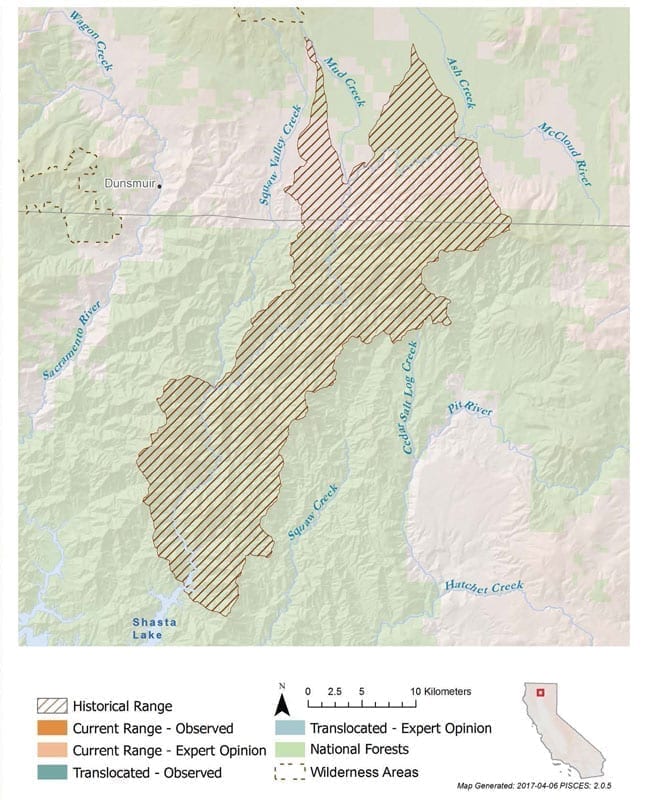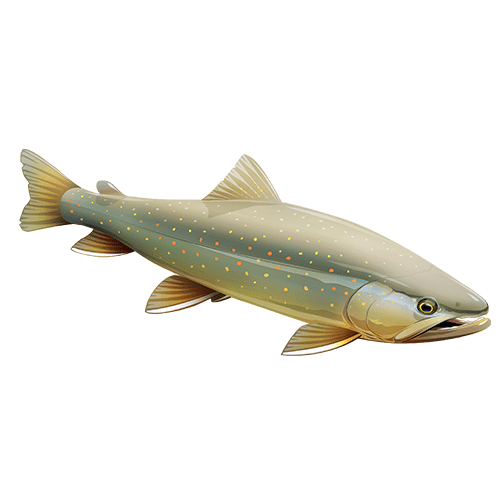What happened to the Bull trout?
Climate Change Impact
“Something will have gone out of us as a people if we ever let the remaining wilderness be destroyed; if we permit the last virgin forests to be turned into comic books and plastic cigarette cases; if we drive the few remaining members of the wild species into zoos or to extinction; if we pollute the last clear air and dirty the last clean streams and push our paved roads through the last of the silence … We simply need that wild country available to us … For it can be a means of reassuring ourselves of our sanity as creatures, a part of the geography of hope.”
Wallace StegnerScroll down for more information about the Bull trout. To read the full species account, click here.
Where to find Bull Trout Salmon:
Bull Trout Distribution
Bull trout were historically found throughout the McCloud River from its mouth to the Lower Falls, and could have potentially lived in the spring-fed upper Sacramento and Pit Rivers as well. Today, the southern extent of their range is in the Klamath River Basin in Oregon and the Jarbridge River Basin in Nevada and range as far north as the Yukon River in British Columbia.
How the Bull Trout Scored:

Characteristics
Bull trout are a large species of trout that specialize in eating fish. They typically thrive in cold water habitats with abundant juvenile salmon or trout that they can ambush from below. Their bodies are dark olive in color, with small red spots on the sides and yellowish spots near the tail and cream leading edges of their fins. Their eyes sit on top of their large, flat heads. Bull trout from the McCloud River were said to reach lengths near 70 cm (about 28 in.) and weigh up to 7.3 kg (about 16 lbs.). The California record was caught in McCloud Reservoir and weighed about 5.1 kg (about 11 lbs.). They are capable of living over twenty years of age.
Abundance
In the 1930s, Bull trout supported a small fishery in the McCloud River. By the 1950s, after the construction of Shasta Dam, they were already scarce throughout the river. The last known Bull trout in California was caught by University of California, Davis graduate student Jamie Sturgess in 1975, tagged, and released.
Habitat & Behavior
McCloud River, ideal habitat for Bull trout. Photo: Mike Wier[/caption] Bull trout require extremely cold, clear water that historically was present in springs in the McCloud River and some of its tributaries. Bull trout can express a variety of life histories, including a) adfluvial, where juveniles grow in streams, migrate to lakes to mature, and then adults migrate to spawn in their natal streams, b) fluvial, where all stages live in streams, but adults migrate to small tributaries for spawning), c) stream resident fish with no separation of life history stages, or d) anadromous, where immature fish and adults undertake repeated estuary and/or ocean migrations to attain large sizes and seek more abundant sources of prey. Adult Bull trout in rivers and smaller streams prefer to live on the bottom in deep pools, and presumably, McCloud River Bull trout fed on abundant Chinook salmon eggs and juveniles year-round. Historically, it is thought that the McCloud River population was fluvial, with fish growing in large pools in the lower river before migrating upstream to spawn in smaller tributaries. Most Bull trout mature at around four or five years of age, and spawning probably took place in September or October when food was most abundant for hatching fry.
Genetics
Bull trout are members of the char family (Salvelinus), along with the more common but non-native, Brook “trout” that are now widespread in California. From museum specimens, scientists determined that Bull trout in California were distinct enough from other populations to warrant their own Evolutionary Significant Unit (ESU) if they were still present in California.






















 Dams block access to historical spawning and rearing habitats. Downstream, dams alter the timing, frequency, duration, magnitude, and rate of change of flows decreasing habitat quality and survival.
Dams block access to historical spawning and rearing habitats. Downstream, dams alter the timing, frequency, duration, magnitude, and rate of change of flows decreasing habitat quality and survival.